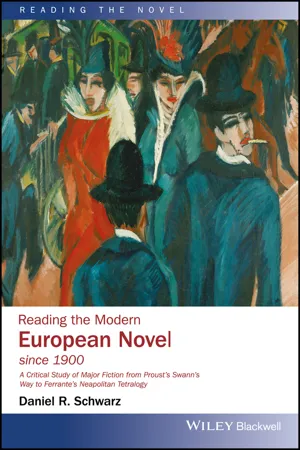
- English
- ePUB (mobile friendly)
- Available on iOS & Android
Reading the Modern European Novel since 1900
About This Book
An exploration of the modern European novel from a renowned English literature scholar
Reading the Modern European Novel since 1900 is an engaging, in-depth examination of the evolution of the modern European novel. Written in Daniel R. Schwarz's precise and highly readable style, this critical study offers compelling discussions on a wide range of major works since 1900 and examines recurring themes within the context of significant historical events, including both World Wars and the Holocaust. The author cites important developments in the evolution of the modern novel and explores how these paradigmatic works of fiction reflect intellectual and cultural history, including developments in painting and cinema. Schwarz focuses on narrative complexity, thematic subtlety, and formal originality as well as how novels render historical events and cultural developments Discussing major works by Proust, Camus, Mann, Kafka, Grass, di Lampedusa, Bassani, Kertesz, Pamuk, Kundera, Saramago, Muller and Ferrante, Schwarz explores how these often experimental masterworks pay homage to the their major predecessors—discussed in Schwarz's ground-breaking Reading the European Novel to 1900 —even while proposing radical departures from realism in their approach to time and space, their testing the limits of language, and their innovative ways of rendering the human psyche.
Written for teachers and students by a highly-acclaimed scholar and including valuable study questions, Reading the Modern European Novel since 1900 offers a guide for a deeper understanding of how these original modern masters respond to both the past and present.
Frequently asked questions
Information
Chapter 1
Introduction: The Novel After 1900
“What we write about fiction is never an objective response to a text; it is always part of a bigger mythmaking – the story we are telling ourselves about ourselves.”Jeanette Winterson1
Basic Premises
What is Modernism?
The European bourgeois ideal of autonomous individuality was widely believed to be the natural outcome of a long development, a process that, although threatened by various disruptions, was assumed to be the basic, progressive movement of humanity. By the turn of the century, however, evolutionist confidence began to falter, and a new ethnographic conception of culture became possible. The word began to be used in the plural, suggesting a world of separate, distinctive, and equally meaningful ways of life. The ideal of an autonomous, cultivated subject could appear as a local project, not a telos for all humankind. (Clifford, The Predicament of Culture, 92–93)3
Duration is the continuous progress of the past which gnaws into the future and which swells as it advances. … The piling up of the past upon the past goes on without relaxation. In reality, the past is preserved by itself, automatically. In its entirety, probably, it follows us at every instant; all that we have felt, thought, and willed from our earliest infancy is there, leaning over the present which is about to join it, pressing against the portals of consciousness that would fain leave it outside. (Ellmann and Feidelson, Jr., The Modern Tradition, 725)5
compels a man to write not merely with his own generation in his bones, but with a feeling that the whole of the literature of Europe from Homer and within it the literature of his own country has a simultaneous existence and composes a simultaneous order. … No poet, no artist of any art, has his complete meaning alone. His significance, his appreciation is the appreciation of his relation to the dead poets and artists. You cannot value him alone; you must set him, for contrast and comparison, among the dead. I mean this as a principle of aesthetic, not merely historical, criticism. (Eliot, Selected Essays, 4)6
Table of contents
- Cover
- Title Page
- Table of Contents
- Acknowledgments
- Also by Daniel R. Schwarz
- Chapter 1: Introduction
- Chapter 2: Cultural Crisis
- Chapter 3: Proust’s Swann’s Way (1913) and the Novel of Sensibility
- Chapter 4: The Metamorphosis (1915)
- Chapter 5: Camus’s Indifferent, Amoral, and Godless Cosmos
- Chapter 6: Why Giorgio Bassani Matters
- Chapter 7: The Novel as Elegy
- Chapter 8: Günter Grass’s The Tin Drum (1959)
- Chapter 9: Imre Kertész’s Fatelessness (1975)
- Chapter 10: Milan Kundera’s The Unbearable Lightness of Being (1984)
- Chapter 11: Saramago’s The History of the Siege of Lisbon (1989)
- Chapter 12: Orhan Pamuk’s My Name is Red (1998)
- Chapter 13: Herta Müller’s The Hunger Angel (2009)
- Chapter 14: Elena Ferrante’s Neapolitan Quartet
- Selected Bibliography (Including Works Cited)
- Index
- End User License Agreement